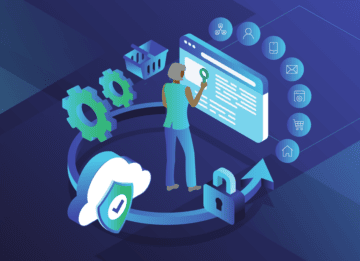
6 Identity Resolution Use Cases to Inspire Your Marketing
A lot of marketers are still trying to get their heads around identity resolution—what it is, how it works, why you’d want it, how ridiculously darn awesome it is. Let’s make it plain with some identity resolution use cases, shall we?
When you can imagine colorful examples of identity in action, it’s a lot easier to understand how it helps to:
-
- Reconcile customer identities
- Improve marketing campaign effectiveness
- Deliver personalized experiences that drive conversion, retention, and loyalty
- Improve attribution, tracking, and decision-making
- Enable compliance
You get the idea.
Identity Resolution Use Cases
Some of these identity resolution use cases are actually brilliant examples from real clients. Others are things we’ve dreamed up to inspire you (but still completely doable if they tickle your fancy).
Use Case #1: Food delivery service prioritizes social influencers
No restaurant or delivery service wants to get blasted on Twitter, no matter who authors the tweet. But unsatisfied diners with lots of followers are more dangerous than others.
One such delivery service uses real-time identity resolution to identify people with large social networks as they order food—then increase driver compensation when they choose to fill these orders. In other words, the more followers you have, the faster you’ll get your food and the better your service is likely to be, reducing the likelihood of bad press.
Related Content: Identity Resolution 101: What Marketers Need to Know
How does it work?
The platform integrates a real-time identity resolution solution via API and matches the users’ mobile ad ID (MAID) to their social handles. This whole calculation is done in milliseconds, on the backend of the ordering platform, and it’s invisible to the delivery drivers, restaurants, and especially the customers.
Has your jaw dropped yet?
Use Case #2: Real estate firms get to know buyers and sellers better
Making an offer on a house has always been a bit of a guessing game—but that game just got a lot easier with identity resolution.
Using identity resolution, realtors and their brokers can input a physical address and match it to the privacy-protected PersonID of the seller. Then, they can enrich what they know about that seller, uncovering key insights to inform their offer, such as:
-
- How much they owe on their mortgage
- Car loans in their names
- Household composition
- Household income
- Etc.
It’s like having their own little private investigator, but no PII is ever divulged or compromised.
Imagine how much easier it is to put an offer on a two-bedroom condo when you know the owner just had a second child (they probably want out of there, stat).
On the flip side, realtors can get to know buyers with identity resolution, too. When that condo owner visits a broker’s website and starts poking around, she can immediately be flagged as someone who probably needs to upgrade the size of her pad, and the site can suggest appropriate homes available in her area.
Impressive identity resolution use case, huh?
Use Case #3: Auto brands get more customers to the dealership
Auto brands spend big bucks creating ads that feature their loaded pickup trucks traversing along a beach. Their sleek sports cars speeding down a desolate desert highway. Or their hybrid-electric sedan seamlessly navigating city life.
But each of these vehicles is going to appeal to a very different audience.
Identity resolution can help auto manufacturers and dealers get the right messaging, offers, and creative to exactly the right audience—to win more customers.
The first step is to get the brand’s offline CRM data online via data onboarding. Then, you’ll be able to recognize each of these people in the digital realm—and add to what you know about them via data enrichment. When a prospect or customer visits the brand’s website, you’ll know things like:
-
- Make and model of their current vehicle(s)
- When they purchased their current vehicle
- Household composition
- Types of cars and features they’ve been browsing for
- Etc.
For example, when Megan shows up, you know she lives alone in the city and has a beater of a sedan that’s 14 years old. Personalize her experience by offering her new sedans, and focus on the fun stuff she’s been missing out on, like heated seats and Bluetooth integration for her music.
Never seen Megan before? No worries—identity resolution can still uncover these data points and insights, even when the visitor is unknown unauthenticated.
Identity resolution is great for retention, too.
Once Megan buys that new sedan, you can be sure to reach her across the multiple channels she frequents, by appending hashed emails and MAIDS to her record. This means you can remind her when she’s due to come in for an oil change or preventative maintenance, and you can discreetly communicate any recalls that may pop up for her vehicle.
Use Case #4: Banks go digital while meeting compliance mandates
Anyone that works in a highly-regulated space like financial services is familiar with the many and varied hoops you must jump through to stay secure and compliant.
One marketing agency was facing the challenge of ingesting customer names and addresses for a variety of banking clients. These banks wanted to modernize their traditionally analog marketing efforts (which were overly reliant on unpersonalized direct mail), but going digital with customer data presented privacy risks.
Related Content: The Identity Graph—What Every Marketer Needs to Know
To keep all of this customer data completely secure, the agency created a private cloud for each banking client. This allows the client to work on a private, encrypted graph, siloed from FullContact’s main identity graph.
Now, the banking client shares names and addresses with the private clouds and receives back everything they need to engage people digitally:
-
- Hashed emails
- MAIDs
- Social handles
- Demographics
- Behavioral information
- And more
So, instead of a generic new credit card offer going out via USPS, Jane gets online display ads for a credit card that rewards her travel habit with bonus travel points. Jeff gets digital messaging with mortgage offers because he lives in a small condo and just recently got married.
And they can recognize Jane and Jeff as soon as they visit the bank’s website.
Plus, each bank remains totally in control of their first-party data.
Use Case #5: eComm sites verify identity for discounts—and high-value purchases
Military, healthcare workers, first responders, veterans, teachers.
Lots of businesses want to offer discounts to certain sets of people they value and respect. But how do you make sure the shopper is actually a firefighter, for example?
Identity resolution works here, too—without the cumbersome and invasive process that asks for your social security number, a photo of your work ID, and your first-born child.
eCommerce sites can request simple inputs, like email address, phone numbers, or name/address, and quickly verify status in any number of employment-related groups.
But if you’re selling a high-ticket item (Tiffany’s bracelet, anyone?) rather than giving a discount, you may also want to verify the identity of the buyer. It would be a shame to send something so valuable to a fraudster. Instead, the brand can just collect that email address to be confident they’re shipping their item to a legit buyer.
Use Case #6: Community centers attract local members
Community centers, churches, and other geographically-limited nonprofits need to reach people in their locales, get them into the facility, and get them involved.
One such national community center organization uses identity resolution to make it happen.
The first step was to de-dupe their contact list. People had been visiting this organization in person, streaming exercise and cooking classes, interacting with the center on social media, sending their children to camp and after school care, and more.
That’s a lot of data sources.
After onboarding their CRM data and resolving these unique identifiers against the identity graph, they found they had half as many real people on their list as they did contact records. Now, they can reach these people more efficiently (goodbye, wasted spend) with a more positive experience (see you later, duplicate emails).
Next up, this community center began using identity resolution to identify people as they show up on the center’s website—even if they aren’t logged in—and tie the identity back to their CRM file. They can tell who is a returning member and who is not yet in their member file, then append insights and contact details (hashed emails, MAIDs) to assist in their communications.
For example, the community center can gather insights on each person like:
-
- Hobbies
- Reading interests
- Music
- Sporting interests
- Diet concerns
- Marital status
- Kids in household
- Age
- Gender
Let’s say the center will be hosting a new seminar on nutrition. They can reach all of their members AND their website visitors that may be interested in diet concerns. Or perhaps they want to increase participation in their senior living group—they can easily reach people above a certain age threshold.
And they can tell who lives in their catchment with data points like:
-
- Region
- County code
- Carrier route
This is one of our favorite identity resolution use cases.
ID resolution still not clicking for you?
There are nearly endless identity resolution use cases to make identity resolution work for you and your brand—across the customer journey.
If the idea of identity is still a little foggy, make sure to check out our layman’s guide to ID resolution—Identity Resolution 101: What Marketers Need to Know.
Recent Blogs
-
 February 25, 2025 Introducing Email Signals: Unlock Powerful Email Engagement Insights Customer 360, Customer Experience, Marketing & Sales, Enrich API
February 25, 2025 Introducing Email Signals: Unlock Powerful Email Engagement Insights Customer 360, Customer Experience, Marketing & Sales, Enrich API -
 August 28, 2024 The Sales Rep's Guide to Maximizing Productivity with Website Visitor Data Acumen, Media Personalization, Marketing & Sales
August 28, 2024 The Sales Rep's Guide to Maximizing Productivity with Website Visitor Data Acumen, Media Personalization, Marketing & Sales -
 August 6, 2024 Turn Visitors into Leads: How to Install the Acumen Web Tag in 5 Easy Steps Acumen, Website Recognition
August 6, 2024 Turn Visitors into Leads: How to Install the Acumen Web Tag in 5 Easy Steps Acumen, Website Recognition